Basically, the Azure Event Grid eventing Pub/Sub model can handle two messaging/mediation patterns such as Fan-In pattern and Fan-Out (broadcasting) pattern. The following screen snippets show their differences:


The logical connectivity between the Event Source and Event Sink is described by Subscription which it is basically a metadata artifact of the Pub/Sub model. Each logical connectivity (represented by Subscription) is independent and loosely decouple to others. In other words, each subscriber can handle in this Pub/Sub model only one logical connectivity such as only one event source.
Your question is related to the Fan-Out (broadcasting) pattern, where the event interest is broadcasting to the multiple subscribers using a PushWithAck delivery mode. Each subscription within this Fan-Out pattern has own "a message state delivery machine" declared by subscriber such as retrying option, deadlettering, filtering, etc.
In other words, the event delivery to the subscribers is processing in parallel way based on their subscription in the transparent manner without any dependences each other. Note, that the subscriber doesn't have any information about who, where, how, etc. are event delivering to other once, so each subscriber can see only own delivery state, for instance, the value of the Aeg-Delivery-Count shows a retry counter of the state machine.
So, in the case of the failed event delivery to the one of the multiple subscribers, the enabled retrying process is performing only for that subscriber.

